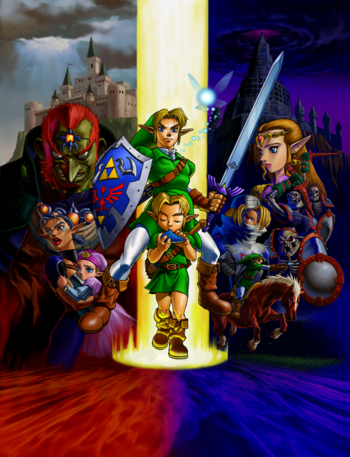
Ocarina of Time is the fifth entry in The Legend of Zelda series, originally released for the Nintendo 64 in November 1998 in Japan and North America, followed by Europe in December.
It is the first 3D game in the series and the first Fifth Generation title, and it set the standard for all the later games in the series, with its then-unheard-of style of cinematic presentation and introduction of many mainstay elements of the franchise. It's also the first Zelda game that Eiji Aonuma worked on.
The story follows a young boy named Link, the only member of his forest village without a fairy. Following some prophetic dreams, he is gifted a fairy named Navi by the Great Deku Tree — the guardian of the forest — and asked for his help to remove an evil curse. This is merely the start of an epic journey that takes Link from the sanctuary of his Hidden Elf Village to the magnificent Hyrule Castle and then to all points of Hyrule in a quest to stop the evil thief-king Ganondorf from seizing the power of the omnipotent Triforce.
Unfortunately, things don't go according to plan. Link is sealed away, and when he wakes up seven years later, Hyrule has become a dark and twisted version of its former self. All is not lost though: there exists one final hope in Link, who is now old enough to wield the Master Sword and accept his true destiny as the Hero of Time. Using his new powers, Link must travel across the broken Hyrule, and across time, to re-assemble the shattered forces of good for an epic final showdown with the King of Evil.
According to Hyrule Historia, this game takes place fourth in the overall timeline of the series and its events cause a three-way split in time, with each Alternate Timeline branching off from its events. Its immediate chronological sequel starring the same Link is Majora's Mask, which takes place after Link has been sent back in time and is transported to Termina while on a search for Navi.
The game has had numerous rereleases — in particular, Master Quest, a preorder bonus for The Wind Waker in 2002, which included the original game along with a second version (originally intended for release on the 64DD add-on) with harder dungeons.
The game had a remake produced by Grezzo for the Nintendo 3DS in 2011, titled The Legend of Zelda: Ocarina of Time 3D, which updated the visuals and controls, but left the story, musicnote , world, and even some of the glitches and bugs intact. The Master Quest version of dungeons was also an unlockable in the 3DS remakenote - this time adding extra twists by flipping the entire game world horizontally in the tradition of the Wii version of Twilight Princess, but also doubling the damage Link takes from enemies and obstacles.
